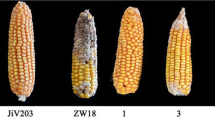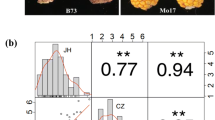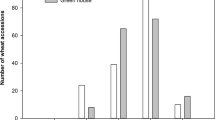Abstract
Fusarium verticillioides and F. graminearum cause ear rots in maize (Zea mays L.) that reduce yield and contaminate the grain with mycotoxins produced by the fungi. To map QTLs for resistance to these ear rots, a F5 mapping population, consisting of 298 recombinant inbreds obtained by randomly selfing of the cross between LP4637 (moderately resistant) and L4674 (susceptible), was genotyped with 250 single nucleotide polymorphism markers and phenotyped 2 years for disease severity after silk inoculation with conidial suspensions of F. verticillioides and F. graminearum. Four QTLs were mapped in chromosomes 2, 3 and 5, bins 2.03, 3.05, 3.07 and 5.07, explaining ranges of 11.2–11.8, 3.4–5.1, 6.2–7.6 and 3.8–5.0 of phenotypic variances (%), respectively, depending on year and fungus. Additive effects of each QTL ranged from 5.0 to 11.9 % of ear area covered by mold and no epistatic interactions were observed. The four QTLs were effective for both Fusarium species and environments indicating that LP4637 is a source of broad resistance to Fusarium stable across environments. These results are consistent with previous research reporting QTLs for ear rot resistance in the same chromosome regions from sources of resistance growing in North America, Africa, Europe and China.

Similar content being viewed by others
References
Alvarez Prado S, López CG, Gambín BL, Abertondo VJ, Borrás L (2012) Dissecting the genetic basis of physiological processes determining maize kernel weight using the IBM (B73 × Mo17) Syn4 population. Field Crops Res 145:33–43
Chen J, Ding J, Li H, Li Z, Sun X, Wang R, Dai X, Dong H, Song W, Chen W, Xia Z, Wu J (2012) Detection and verification of quantitative trait loci for resistance to Fusarium ear rot in maize. Mol Breed 30:1649–1656
Ding JQ, Wang XM, Chander S, Yan JB, Li JS (2008) QTL mapping of resistance to Fusarium ear rot using a RIL population in maize. Mol Breed 22:395–403
Fan JB, Oliphant A, Shen R, Kermani BG, Garcia F, Gunderson KL, Hansen M, Steemers F, Butler SL, Deloukas P, Galver L, Hunt S, McBride C, Bibikova M, Rubano T, Chen J, Wickham E, Doucet D, Chang W, Campbell D, Zhang B, Kruglyak S, Bentley D, Haas J, Rigault P, Zhou L, Stuelpnagel J, Chee MS (2003) Highly parallel SNP genotyping. Cold Spring Harb Symp Quant Biol 68:69–78
Hallauer AR, Miranda Filho JB (1988) Quantitative genetics in maize breeding, 2nd edn. Iowa State University Press, Ames
Huang X, Paulo MJ, Boer M, Effgen S, Keizer P, Koornneef M, van Eeuwijk FA (2011) Analysis of natural allelic variation in Arabidopsis using a multiparent recombinant inbred line population. Proc Natl Acad Sci USA 108:4488–4493
Iglesias J, Presello DA, Botta G, Lori GA, Fauguel CM (2010) Aggressiveness of Fusarium Section Liseola isolates causing maize ear rot in Argentina. Eur J Plant Pathol 92:205–211
Jiang C, Zeng ZB (1995) Multiple trait analysis of genetic mapping for quantitative trait loci. Genetics 140:1111–1127
Kumi J, Mitchell NJ, Asare GA, Dotse E, Kwaa F, Phillips TD, Ankrah NA (2014) Aflatoxin and fumonisin contamination of home-made food (Weanimix) from cereal-legume blends for children. Ghana Med J 48:121–126
Liakat Ali M, Taylor JH, Jie L, Sun G, William M, Kasha KJ, Reid LM, Pauls KP (2005) Molecular mapping of QTLs for resistance to Gibberella ear rot, in corn, caused by Fusarium graminearum. Genome 48:521–533
Lorieux M (2007) Map Disto, a free user-friendly program for computing genetic maps. In: Computer demonstration (P958) given at the plant and animal genome XV conference, San Diego, CA
Luna JT, Kugler WF, Godoy EF, Mazzoni L (1964). Maíz. In: Parodi L (ed) Enciclopedia Argentina de Agricultura y jardinería, vol 111, primera parte. Buenos Aires, p 553–589
Malosetti M, Ribaut JM, Vargas M, Crossa J, Van Eeuwijk FA (2008) A multi-trait multi-environment QTL mixed model with an application to drought and nitrogen stress trials in maize (Zea mays L.). Euphytica 161:241–257
Martin M, Miedaner T, Dhillon BS, Ufermann U, Kessel B, Ouzunova M, Schipprack W, Melchinger AE (2011) Colocalization of QTL for Gibberella ear rot resistance and low mycotoxin contamination in early European maize. Crop Sci 51:1935–1945
Martin M, Miedaner T, Schwegler D, Kessel B, Ouzunova M, Dhillon BS, Schipprack W, Utz HF, Melchinger AE (2012) Comparative quantitative trait loci mapping for Gibberella ear rot resistance and reduced deoxynivalenol contamination across connected maize populations. Crop Sci 52:32–43
Mideros SX, Warburton ML, Jamann TM, Windham GL, Williams WP, Nelson RJ (2014) Quantitative trait loci influencing mycotoxin contamination of maize: analysis by linkage mapping, characterization of near-isogenic lines and meta-analysis. Crop Sci 54:127–142
Mrode RA (2005) Linear models for the prediction of animal breeding values, 2nd edn. CAB International, Wallingford
Nowak A, Slizewska K, Gajecka M, Piotrowska M, Zakowska Z, Zielonka L, Gajecki M (2015) The genotoxicity of caecal water from gilts following experimentally induced Fusarium mycotoxicosis. Vet Med Czech 60:133–140
Olmos SE, Delucchi C, Ravera M, Negri ME, Mandolino C, Eyhérabide GH (2014) Genetic relatedness and population structure within the public Argentinean collection of maize inbred lines. Maydica 59:16–31
Patterson HD (1997) Analysis of series of variety trials. In: Kempton RA, Fox PN (eds) Statistical methods for plant variety evaluation. Chapman and Hall, London, pp 139–161
Pérez Brito D, Jeffers DP, González de León D, Khairallah MM, Cortés Cruz CM, Velázquez Cardelas C, Azpíroz Rivero S, Srinivasan G (2001) QTL mapping of Fusarium moniliforme ear rot resistance in highland maize, Mexico. Agrociencia 35:181–196
Piepho HP, Möhring J, Melchinger AE, Büchse A (2008) BLUP for phenotypic selection in plant breeding and variety testing. Euphytica 161:209–228
Presello DA, Reid LM, Butler G, Mather DE (2005) Pedigree selection for Gibberella ear rot resistance in maize. Euphytica 143:1–8
Presello DA, Iglesias J, Botta G, Reid LM, Lori GA, Eyhérabide GH (2006) Stability of maize resistance to the ear rots caused by Fusarium graminearum and F. verticillioides in Argentinian and Canadian environments. Euphytica 147:403–407
Presello DA, Iglesias J, Botta G, Eyhérabide GH (2007) Severity of Fusarium ear rot and concentration of fumonisin in grain of Argentinian maize hybrids. Crop Prot 26:852–855
Presello DA, Botta G, Iglesias J, Eyhérabide GH (2008) Effect of disease severity on yield and grain fumonisin concentration of maize hybrids inoculated with Fusarium verticillioides. Crop Prot 27:572–576
Presello DA, Pereyra AO, Iglesias J, Fauguel CM, Sampietro DA, Eyhérabide GH (2011) Responses to selection of S5 inbreds for broad-based resistance to ear rots and grain mycotoxin contamination caused by Fusarium spp. in maize. Euphytica 178:23–29
Reid LM, Hamilton RI, Mather DE (1996) Screening maize for resistance to Gibberella ear rot. Tech. Bull. Publ. 1996-5E. Agriculture and Agri-Food Canada, Ottawa
Rey JI, Cerono J, Lúquez J (2009) Identification of quantitative trait loci for resistant to maize ear rot caused by Fusarium moniliforme Sheldon and common rust caused by Puccinia sorghi in Argentinian maize germplasm. Rev Fac Agron Univ Nac La Plata 108:1–8
Robertson-Hoyt LA, Kleinschmidt CE, White DG, Payne GA, Maragos CM, Holland JB (2006a) Heritabilities and correlations of Fusarium ear rot resistance and fumonisin contamination resistance in two maize populations. Crop Sci 46:353–361
Robertson-Hoyt LA, Jines MP, Balint-Kurti PJ, Kleinschmidt CE, White DG, Payne GA, Maragos CM, Molnár TL, Holland JB (2006b) QTL mapping for Fusarium ear rot and fumonisin contamination resistance in two maize populations. Crop Sci 46:1734–1743
Robertson-Hoyt LA, Betrán J, Payne GA, White DG, Isakeit T, Maragos CM, Molnár TL, Holland JB (2007) Relationships among resistances to Fusarium and Aspergillus ear rots and contamination by fumonisin and aflatoxin in maize. Phytopathology 97:311–317
Sampietro DA, Marín P, Iglesias J, Presello DA, Vattuone MA, Catalán CA, Gonzalez Jaen MT (2010) A molecular based strategy for rapid diagnosis of toxigenic Fusarium species associated to cereal grains from Argentina. Fungal Biol 114:74–81
SAS Institute (1999) SAS OnlineDoc, version 8. Institute, Inc., Cary
Takuno S, Terauchi R, Innan H (2012) The power of QTL mapping with RILs. PLoS One 7:e46545
Tembo L, Asea G, Gibson PT, Okori P (2014) Quantitative trait loci for resistance to Stenocarpella maydis and Fusarium graminearum cob rots in tropical maize. J Crop Improv 28:214–228
Wang S, Basten CJ, Zeng ZB (2011) Windows QTL cartographer 2.5. Department of Statistics, North Carolina State University, Raleigh
Warburton ML, Tang JD, Windham GL, Hawkins LK, Murray S, Xu W, Boykin DL, Perkins A, Williams WP (2015) Genome wide association mapping of Aspergillus flavus and aflatoxin accumulation resistance in maize. Crop Sci 55:1–11
Xiang K, Zhang ZM, Reid LM, Zhu X, Yuan GS, Pan GT (2010) A meta-analysis of QTL associated with ear rot resistance in maize. Maydica 55:281–290
Zhang F, Wan XQ, Pan GT (2007) Molecular mapping of QTL for resistance to maize ear rot caused by Fusarium moniliforme. Acta Agron Sin 33:491–496
Acknowledgments
This research was supported by Grants from the Instituto Nacional de Tecnología Agropecuaria (PNCER-1332), Secretaría de Ciencia y Técnica (PICT-PAE36047 Nº 77/07) and Consejo Nacional de Investigaciones Científicas y Técnicas, Argentina. Genotyping was conducted by Pioneer Hi-Bred International, Inc. The authors thank to Santiago Alvarez Prado and Gerardo Cervigni for assistance in statistical analysis.
Author information
Authors and Affiliations
Corresponding author
Rights and permissions
About this article
Cite this article
Giomi, G.M., Kreff, E.D., Iglesias, J. et al. Quantitative trait loci for Fusarium and Gibberella ear rot resistance in Argentinian maize germplasm. Euphytica 211, 287–294 (2016). https://doi.org/10.1007/s10681-016-1725-z
Received:
Accepted:
Published:
Issue Date:
DOI: https://doi.org/10.1007/s10681-016-1725-z




